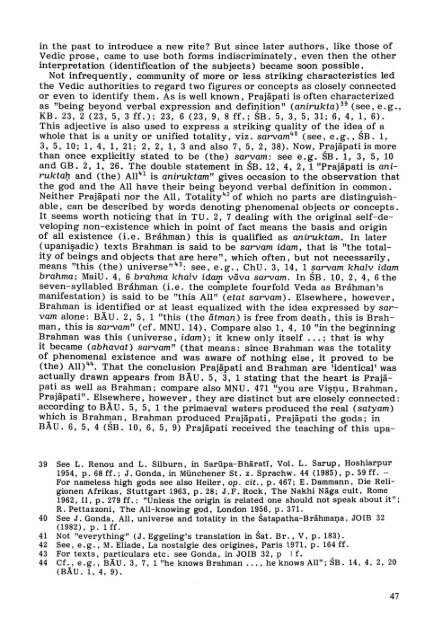Prajapati's relations with Brahman, Brhaspati and Brahma - DWC
Prajapati's relations with Brahman, Brhaspati and Brahma - DWC
Prajapati's relations with Brahman, Brhaspati and Brahma - DWC
Create successful ePaper yourself
Turn your PDF publications into a flip-book with our unique Google optimized e-Paper software.
in the past to introduce a new rite? But since later authors, like those of<br />
Vedic prose, came to use both forms indiscriminately, even then the other<br />
interpretation (identification of the subjects) became soon possible.<br />
Not infrequently, community of more or less striking characteristics led<br />
the Vedic authorities to regard two figures or concepts as closely connected<br />
or even to identify them. As is well known, Prajäpati is of ten characterized<br />
as "being beyond verbal expression <strong>and</strong> defiryition" (anirukta) 39 (see, e. g.,<br />
KB. 23, 2 (23,5,3 ff.); 23, 6 (23, 9, 8 ff.; SB. 5, 3, 5, 31; 6, 4,1,6).<br />
This adjective is also used to express a striking quality of the ide~ of a<br />
whole that is a unity or unified totality, viz. sarvam" o (see, e. g. , SB. 1,<br />
3, 5, 10; 1, 4, 1, 21; 2, 2, 1, 3 <strong>and</strong> also 7, 5, 2, 38). Now, Prajäpati is more<br />
than on ce explicitly stated to be (the) sarvam: see e. g. SB. 1, 3, 5, 10<br />
<strong>and</strong> GB. 2, 1, 26. The double statement in SB. 12, 4, 2, 1 "Prajäpati is anirukta1)<br />
<strong>and</strong> (the) All .. 1 is aniruktam" gives occasion to the observation that<br />
the god <strong>and</strong> the All have their being beyond verbal definition in common.<br />
Neither Prajäpati nor the All, Totality"z of which no parts are distinguishable,<br />
can be described by words denoting phenomenal objects or concepts .<br />
It seems worth noticing that in TU. 2, 7 dealing <strong>with</strong> the original self-developing<br />
non-existence which in point of fact means the basis <strong>and</strong> origin<br />
of all existence (Le. Bráhman) this is qualified as aniruktam. In later<br />
(upani!?adic) texts <strong><strong>Brahma</strong>n</strong> is said to be sarvam idam, that is "the totality<br />
of beings <strong>and</strong> objects that are here", which of ten , but not necessarily,<br />
means "this (the) universe""3: see, e.g., ChU. 3,14,1 sarvam khalv idam<br />
brahma; MaiU. 4, 6 brahma khalv idam vava sarvam. In SB. 10, 2, 4, 6 the<br />
seven-syllabled Bráhman (Le. the complete fourfold Veda as Bráhman 's<br />
manifestation) is said to be "this All" (etat sarvam). Elsewhere, however,<br />
<strong><strong>Brahma</strong>n</strong> is identified or at least equalized <strong>with</strong> the idea expressed by sarvam<br />
alone: BÄU. 2, 5, 1 "this (the atman) is free from death, this is <strong><strong>Brahma</strong>n</strong>,<br />
this is sarvam" (cf. MNU. 14). Compare also 1,4,10 "in the beginning<br />
<strong><strong>Brahma</strong>n</strong> was this (universe , idam); it knew only itself ... ; that is why<br />
it became (abhavat) sarvam" (that means: sin ce <strong><strong>Brahma</strong>n</strong> was the totality<br />
of phenomenal existence <strong>and</strong> was aware of nothing else, it proved to be<br />
(the) AIl) ..... That the conclusion Prajäpati <strong>and</strong> <strong><strong>Brahma</strong>n</strong> are 'identical' was<br />
actually drawn appears from BÄ U. 5, 3, 1 stating that the heart is Prajäpati<br />
as well as <strong><strong>Brahma</strong>n</strong>; compare also MNU. 471 "you are Vi!?l).u, <strong><strong>Brahma</strong>n</strong>,<br />
Prajäpati". Elsewhere, however, they are distinct but are closely connected:<br />
according to BÄU. 5, 5, 1 the primaeval waters produced the real (satyam)<br />
which is BrahlI!an, <strong><strong>Brahma</strong>n</strong> produced Prajäpati, Prajäpati the gods; in<br />
BÄU. 6, 5, 4 (SB. 10, 6, 5, 9) Prajäpati received the teaching of this up a-<br />
39 See L. Renou <strong>and</strong> L. Silburn, in Sarüpa-Bhäratï, Vol. L. Sarup, Hoshiarpur<br />
1954, p. 68 ff.; J. Gonda, in Münchener St. z. Sprachw. 44 (1985), p. 59 ff. -<br />
For nameless high gods see also Heiler, op. cit., p. 467; E. Dammann, Die Religionen<br />
Afrikas, Stuttgart 1963, p. 28; J.F. Rock, The Nakhi Näga cult, Rome<br />
1962, II, p. 279 ff.: "Unless the origin is related one should not speak about it";<br />
R. Pettazzoni, The All-knowing god, London 1956, p. 371.<br />
40 See J. Gonda, All, universe <strong>and</strong> totality in the Satapatha-BrähmaQa, JOIB 32<br />
(1982), p. 1ff. ,<br />
41 Not "everything" (J. Eggeling's translation in Sat. Br., V, p.183).<br />
42 See, e. g. , M. Eliade, La nostalgie des origines, Paris 1971, p. 164 ff.<br />
43 For texts, particulars etc. see Gonda, in JOIB 32, P ~ f. ,<br />
44 Cf., e.g., BAU. 3, 7, 1 "he knows<strong><strong>Brahma</strong>n</strong> ... , heknowsAll"; SB. 14,4,2,20<br />
(BAU. 1, 4, 9).<br />
47
















